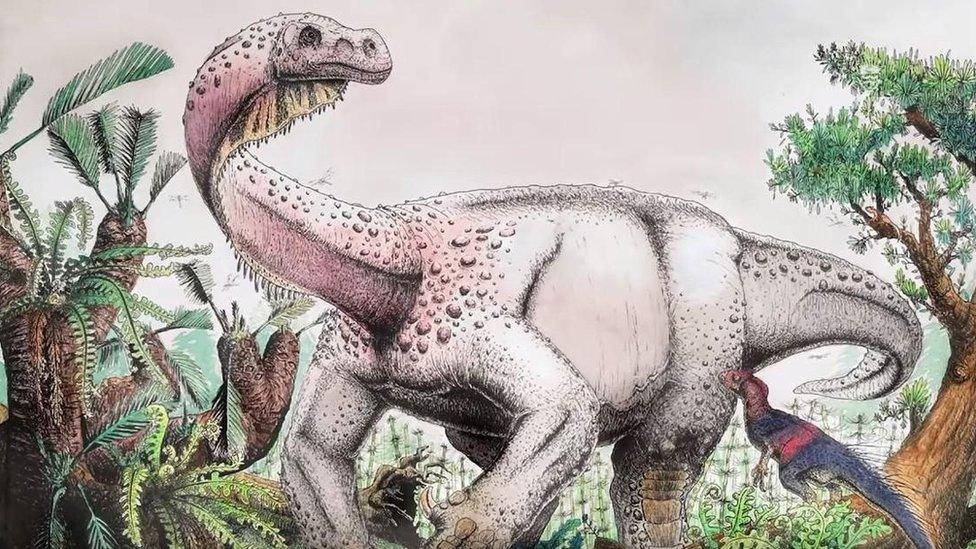New dinosaur species Ledumahadi Mafube found in South Africa
- Published
- comments

Researchers in South Africa have discovered the fossils of a new species and they've called it Ledumahadi Mafube.
It means "a giant thunderclap at dawn" in the local Sesotho language where it was found.
They say it could in fact be the "first true giant" to have evolved on Earth and lived around 200 million years ago during the Jurassic era.
It was the biggest animal alive on Earth at that time - twice the size and weight of an African elephant today.
But it's not the largest dinosaur species ever discovered.
Much bigger dinosaurs like the Argentinosaurus huinculensis and Patagotitan mayorum - the dinosaur thought to have been the biggest that ever lived - came into being much later.
They lived in the late Cretaceous period over 96.6 million years ago, but it's thought the Argentinosaurus huinculensis species might have evolved from Ledumahadi Mafube.
Researchers say the Jurassic period was 199.6 million to 145.5 million years ago.
At that time there was a warm, wet climate that gave rise to lush vegetation and abundant life.
Many new dinosaurs emerged鈥攊n great numbers. Among them were stegosaurs, brachiosaurs, allosaurs, and many others.
Palaeontology professor Jonah Choiniere, led the study at the University of the Witwatersand in Johannesburg.
He said: "The name reflects the great size of the animal as well as the fact that its lineage appeared at the origins of sauropod dinosaurs."
"It honours both the recent and ancient heritage of southern Africa," he adds.
Sauropods are dinosaurs with a long neck and tail, that stood on all four legs, and ate plants, and include well-known species like Brontosaurus.
This is how big the toenail of Ledumahadi was - even larger than a man's hand
Prof Choiniere explains in a YouTube video that 200 million years ago, South Africa was a very different place than it is today.
The region would have had vast flood plains spreading out into the distance, with mountains as big as the Himalayas.
The Himalayas has many of the Earth's highest peaks, including the highest, Mount Everest.
These mountains would have been shedding rock and sediment into the area below, covering up the skeletons of animals that had died there - including Ledumahadi Mafube.
This is where the fossil was found in the Free State province, Johannesburg, South Africa
Prof Choiniere said the first Ledumahadi Mafube fossil was discovered 30 years ago by a professor from the University of the Witwatersand, who brought the fossils back and kept them stored away.
Scientists later returned to the spot where more fossils were uncovered.
The team of researchers say they can be almost certain it walked on all fours.
But they also think this particular dinosaur stood differently to the others of its kind - by crouching like a cat.
Researchers think the Ledumahadi Mafube might have adopted a stance a bit like this Lynx
"This was the animal that wanted to have everything," says lead study author Blair McPhee,
"It wanted to be really big, like a sauropod, and wanted to walk predominantly quadrupedally, like a sauropod.
"But when it came to relinquishing that primitive mobile forelimb, it didn't want to do that."
Maybe if scientists ever figure out a way to bring dinosaurs back, we'll be able to see one in action for ourselves.
- Published16 January 2018
- Published11 January 2018
- Published7 December 2017
- Published9 August 2017
